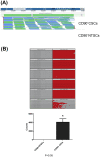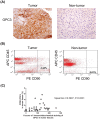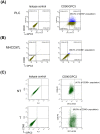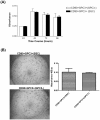Gene expression profiling of liver cancer stem cells by RNA-sequencing
- PMID: 22606345
- PMCID: PMC3351419
- DOI: 10.1371/journal.pone.0037159
Gene expression profiling of liver cancer stem cells by RNA-sequencing
Abstract
Background: Accumulating evidence supports that tumor growth and cancer relapse are driven by cancer stem cells. Our previous work has demonstrated the existence of CD90(+) liver cancer stem cells (CSCs) in hepatocellular carcinoma (HCC). Nevertheless, the characteristics of these cells are still poorly understood. In this study, we employed a more sensitive RNA-sequencing (RNA-Seq) to compare the gene expression profiling of CD90(+) cells sorted from tumor (CD90(+)CSCs) with parallel non-tumorous liver tissues (CD90(+)NTSCs) and elucidate the roles of putative target genes in hepatocarcinogenesis.
Methodology/principal findings: CD90(+) cells were sorted respectively from tumor and adjacent non-tumorous human liver tissues using fluorescence-activated cell sorting. The amplified RNAs of CD90(+) cells from 3 HCC patients were subjected to RNA-Seq analysis. A differential gene expression profile was established between CD90(+)CSCs and CD90(+)NTSCs, and validated by quantitative real-time PCR (qRT-PCR) on the same set of amplified RNAs, and further confirmed in an independent cohort of 12 HCC patients. Five hundred genes were differentially expressed (119 up-regulated and 381 down-regulated genes) between CD90(+)CSCs and CD90(+)NTSCs. Gene ontology analysis indicated that the over-expressed genes in CD90(+)CSCs were associated with inflammation, drug resistance and lipid metabolism. Among the differentially expressed genes, glypican-3 (GPC3), a member of glypican family, was markedly elevated in CD90(+)CSCs compared to CD90(+)NTSCs. Immunohistochemistry demonstrated that GPC3 was highly expressed in forty-two human liver tumor tissues but absent in adjacent non-tumorous liver tissues. Flow cytometry indicated that GPC3 was highly expressed in liver CD90(+)CSCs and mature cancer cells in liver cancer cell lines and human liver tumor tissues. Furthermore, GPC3 expression was positively correlated with the number of CD90(+)CSCs in liver tumor tissues.
Conclusions/significance: The identified genes, such as GPC3 that are distinctly expressed in liver CD90(+)CSCs, may be promising gene candidates for HCC therapy without inducing damages to normal liver stem cells.
Conflict of interest statement
Figures









Similar articles
-
miR-589-5p inhibits MAP3K8 and suppresses CD90+ cancer stem cells in hepatocellular carcinoma.J Exp Clin Cancer Res. 2016 Nov 11;35(1):176. doi: 10.1186/s13046-016-0452-6. J Exp Clin Cancer Res. 2016. PMID: 27835990 Free PMC article.
-
Discrete nature of EpCAM+ and CD90+ cancer stem cells in human hepatocellular carcinoma.Hepatology. 2013 Apr;57(4):1484-97. doi: 10.1002/hep.26168. Epub 2013 Jan 18. Hepatology. 2013. PMID: 23174907 Free PMC article.
-
Sorafenib suppresses extrahepatic metastasis de novo in hepatocellular carcinoma through inhibition of mesenchymal cancer stem cells characterized by the expression of CD90.Sci Rep. 2017 Sep 12;7(1):11292. doi: 10.1038/s41598-017-11848-z. Sci Rep. 2017. PMID: 28900199 Free PMC article.
-
Epigenetic regulation of cancer stem cells in liver cancer: current concepts and clinical implications.J Hepatol. 2010 Sep;53(3):568-77. doi: 10.1016/j.jhep.2010.05.003. Epub 2010 May 31. J Hepatol. 2010. PMID: 20646772 Free PMC article. Review.
-
Targeting Hepatic Cancer Stem Cells (CSCs) and Related Drug Resistance by Small Interfering RNA (siRNA).Cell Biochem Biophys. 2024 Dec;82(4):3031-3051. doi: 10.1007/s12013-024-01423-5. Epub 2024 Jul 26. Cell Biochem Biophys. 2024. PMID: 39060914 Review.
Cited by
-
TCGA whole-transcriptome sequencing data reveals significantly dysregulated genes and signaling pathways in hepatocellular carcinoma.Front Med. 2015 Sep;9(3):322-30. doi: 10.1007/s11684-015-0408-9. Epub 2015 Aug 14. Front Med. 2015. PMID: 26276037
-
The SHH/Gli axis regulates CD90-mediated liver cancer stem cell function by activating the IL6/JAK2 pathway.J Cell Mol Med. 2018 Jul;22(7):3679-3690. doi: 10.1111/jcmm.13651. Epub 2018 May 2. J Cell Mol Med. 2018. PMID: 29722127 Free PMC article.
-
Cancer stem cells of hepatocellular carcinoma.Oncotarget. 2018 May 1;9(33):23306-23314. doi: 10.18632/oncotarget.24623. eCollection 2018 May 1. Oncotarget. 2018. PMID: 29796190 Free PMC article. Review.
-
Myelin-forming cell-specific cadherin-19 is a marker for minimally infiltrative glioblastoma stem-like cells.J Neurosurg. 2015 Jan;122(1):69-77. doi: 10.3171/2014.9.JNS132373. J Neurosurg. 2015. PMID: 25361488 Free PMC article.
-
Haptoglobin expression correlates with tumor differentiation and five-year overall survival rate in hepatocellular carcinoma.PLoS One. 2017 Feb 3;12(2):e0171269. doi: 10.1371/journal.pone.0171269. eCollection 2017. PLoS One. 2017. PMID: 28158312 Free PMC article.
References
-
- Thorgeirsson SS, Grisham JW. Molecular pathogenesis of human hepatocellular carcinoma. Nat Genet. 2002;31:339–346. - PubMed
-
- Lo CM, Ngan H, Tso WK, Liu CL, Lam CM, et al. Randomized controlled trial of transarterial lipiodol chemoembolization for unresectable hepatocellular carcinoma. Hepatology. 2002;35:1164–1171. - PubMed
-
- Ma S, Jiao B, Liu X, Yi H, Kong D, et al. Cancer Treat Rev; 2009. Approach to radiation therapy in hepatocellular carcinoma. - PubMed
Publication types
MeSH terms
Substances
LinkOut - more resources
Full Text Sources
Other Literature Sources
Medical

